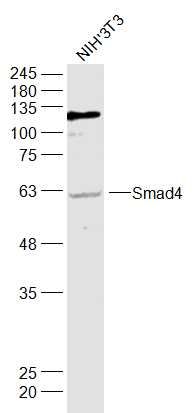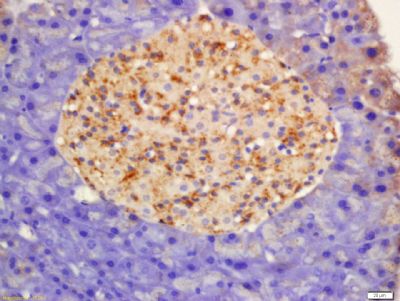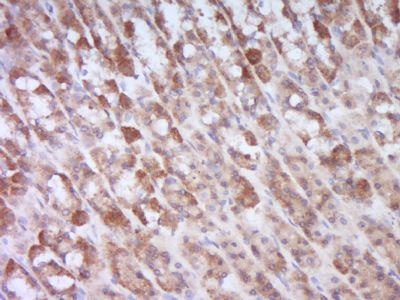产品中心
当前位置:首页>产品中心Anti-Smad4
货号: bs-0585R 基本售价: 380.0 元 规格: 20ul
- 规格:20ul
- 价格:380.00元
- 规格:50ul
- 价格:780.00元
- 规格:100ul
- 价格:1380.00元
- 规格:200ul
- 价格:2200.00元
产品信息
- 产品编号
- bs-0585R
- 英文名称
- Smad4
- 中文名称
- Smad4抗体
- 别 名
- Mothers against decapentaplegic homolog 4; (Small) Mothers Against Decapentaplegic; Deleted in Pancreatic Carcinoma; Deleted in pancreatic carcinoma locus 4; Deletion target in pancreatic carcinoma 4; DPC 4; DPC4; hSMAD4; JIP; MAD homolog 4; MAD mothers against decapentaplegic Drosophila homolog 4; MAD mothers against decapentaplegic homolog 4; MADH 4; MADH4; Med; Medea; Mothers against decapentaplegic homolog 4; Mothers against DPP homolog 4; OTTHUMP00000163548; Smad 4; SMAD family member 4; SMAD mothers against DPP homolog 4.
- 规格价格
- 50ul/780元购买 100ul/1380元购买 200ul/2200元购买 大包装/询价
- 说 明 书
- 50ul 100ul 200ul
- 研究领域
- 肿瘤 细胞生物 信号转导 细胞凋亡 生长因子和激素
- 抗体来源
- Rabbit
- 克隆类型
- Polyclonal
- 交叉反应
- Human, Mouse, Rat,
- 产品应用
- WB=1:500-2000 ELISA=1:500-1000 IHC-P=1:400-800 IHC-F=1:400-800 IF=1:100-500 (石蜡切片需做抗原修复)
not yet tested in other applications.
optimal dilutions/concentrations should be determined by the end user.
- 分 子 量
- 60kDa
- 细胞定位
- 细胞核 细胞浆
- 性 状
- Lyophilized or Liquid
- 浓 度
- 1mg/ml
- 免 疫 原
- KLH conjugated synthetic peptide derived from human Smad4:31-120/545
- 亚 型
- IgG
- 纯化方法
- affinity purified by Protein A
- 储 存 液
- 0.01M TBS(pH7.4) with 1% BSA, 0.03% Proclin300 and 50% Glycerol.
- 保存条件
- Store at -20 °C for one year. Avoid repeated freeze/thaw cycles. The lyophilized antibody is stable at room temperature for at least one month and for greater than a year when kept at -20°C. When reconstituted in sterile pH 7.4 0.01M PBS or diluent of antibody the antibody is stable for at least two weeks at 2-4 °C.
- PubMed
- PubMed
- 产品介绍
- background:
Smad 4 is a member of the Mothers Against Dpp (MAD)-related family of proteins. So far, eight Smads have been identified and can be divided in 3 subgroups based on their structure and functions; pathway-restricted, common mediator and inhibitory Smad. Smad 4 is the common Smad (co-Smad). Previously identified as the tumor suppressor DPC4 (deleted in pancreatic carcinoma, locus 4), Smad 4 is functionally distinct among the Smad family, and is required for the assembly and transcriptional activation of diverse, Smad-DNA complexes. In contrast to the R-Smads, Smad 4 is not regulated by phosphorylation, but acts as a common mediator of TGF-Beta, activin, and bone morphogenetic protein signaling responses. Smad 4 is frequently inactivated in pancreatic, biliary and colorectal tumors.
Function:
Common SMAD (co-SMAD) is the coactivator and mediator of signal transduction by TGF-beta (transforming growth factor). Component of the heterotrimeric SMAD2/SMAD3-SMAD4 complex that forms in the nucleus and is required for the TGF-mediated signaling. Promotes binding of the SMAD2/SMAD4/FAST-1 complex to DNA and provides an activation function required for SMAD1 or SMAD2 to stimulate transcription. Component of the multimeric SMAD3/SMAD4/JUN/FOS complex which forms at the AP1 promoter site; required for syngernistic transcriptional activity in response to TGF-beta. May act as a tumor suppressor. Positively regulates PDPK1 kinase activity by stimulating its dissociation from the 14-3-3 protein YWHAQ which acts as a negative regulator.
Subunit:
Interacts with CITED2 (By similarity). Monomer; in the absence of TGF-beta activation. Heterodimer; on TGF-beta activation. Composed of two molecules of a C-terminally phosphorylated R-SMAD molecule, SMAD2 or SMAD3, and one molecule of SMAD4 to form the transcriptional active SMAD2/SMAD3-SMAD4 complex. Found in a ternary complex composed of SMAD4, STK11/LKB1 and STK11IP. Interacts with ATF2, COPS5, DACH1, MSG1, SKI, STK11/LKB1, STK11IP and TRIM33. Interacts with ZNF423; the interaction takes place in response to BMP2 leading to activation of transcription of BMP target genes. Interacts with ZNF521; the interaction takes place in response to BMP2 leading to activation of transcription of BMP target genes. Interacts with USP9X. Interacts (via the MH1 and MH2 domains) with RBPMS. Interacts with WWTR1 (via coiled-coil domain). Component of the multimeric complex SMAD3/SMAD4/JUN/FOS which forms at the AP1 promoter site; required for syngernistic transcriptional activity in response to TGF-beta. Interacts with CITED1. Interacts with PDPK1 (via PH domain). Interacts with VPS39; this interaction affects heterodimer formation with SMAD3, but not with SMAD2, and leads to inhibition of SMAD3-dependent transcription activation. Interactions with VPS39 and SMAD2 may be mutually exclusive.
Subcellular Location:
Cytoplasm. Nucleus. Note=Cytoplasmic in the absence of ligand. Migrates to the nucleus when complexed with R-SMAD. PDPK1 prevents its nuclear translocation in response to TGF-beta.
Post-translational modifications:
Phosphorylated by PDPK1.
Monoubiquitinated on Lys-519 by E3 ubiquitin-protein ligase TRIM33. Monoubiquitination hampers its ability to form a stable complex with activated SMAD2/3 resulting in inhibition of TGF-beta/BMP signaling cascade. Deubiqitination by USP9X restores its competence to mediate TGF-beta signaling.
DISEASE:
Pancreatic cancer (PNCA) [MIM:260350]: A malignant neoplasm of the pancreas. Tumors can arise from both the exocrine and endocrine portions of the pancreas, but 95% of them develop from the exocrine portion, including the ductal epithelium, acinar cells, connective tissue, and lymphatic tissue. Note=The gene represented in this entry may be involved in disease pathogenesis.
Juvenile polyposis syndrome (JPS) [MIM:174900]: Autosomal dominant gastrointestinal hamartomatous polyposis syndrome in which patients are at risk for developing gastrointestinal cancers. The lesions are typified by a smooth histological appearance, predominant stroma, cystic spaces and lack of a smooth muscle core. Multiple juvenile polyps usually occur in a number of Mendelian disorders. Sometimes, these polyps occur without associated features as in JPS; here, polyps tend to occur in the large bowel and are associated with an increased risk of colon and other gastrointestinal cancers. Note=The disease is caused by mutations affecting the gene represented in this entry.
Juvenile polyposis/hereditary hemorrhagic telangiectasia syndrome (JP/HHT) [MIM:175050]: JP/HHT syndrome phenotype consists of the coexistence of juvenile polyposis (JIP) and hereditary hemorrhagic telangiectasia (HHT) [MIM:187300] in a single individual. JIP and HHT are autosomal dominant disorders with distinct and non-overlapping clinical features. The former, an inherited gastrointestinal malignancy predisposition, is caused by mutations in SMAD4 or BMPR1A, and the latter is a vascular malformation disorder caused by mutations in ENG or ACVRL1. All four genes encode proteins involved in the transforming-growth-factor-signaling pathway. Although there are reports of patients and families with phenotypes of both disorders combined, the genetic etiology of this association is unknown. Note=The disease is caused by mutations affecting the gene represented in this entry.
Colorectal cancer (CRC) [MIM:114500]: A complex disease characterized by malignant lesions arising from the inner wall of the large intestine (the colon) and the rectum. Genetic alterations are often associated with progression from premalignant lesion (adenoma) to invasive adenocarcinoma. Risk factors for cancer of the colon and rectum include colon polyps, long-standing ulcerative colitis, and genetic family history. Note=The disease may be caused by mutations affecting the gene represented in this entry.
Note=SMAD4 variants may be associated with susceptibility to pulmonary hypertension, a disorder characterized by plexiform lesions of proliferating endothelial cells in pulmonary arterioles. The lesions lead to elevated pulmonary arterial pression, right ventricular failure, and death. The disease can occur from infancy throughout life and it has a mean age at onset of 36 years. Penetrance is reduced. Although familial pulmonary hypertension is rare, cases secondary to known etiologies are more common and include those associated with the appetite-suppressant drugs.
Myhre syndrome (MYHRS) [MIM:139210]: A syndrome characterized by pre- and postnatal growth deficiency, mental retardation, generalized muscle hypertrophy and striking muscular build, decreased joint mobility, cryptorchidism, and unusual facies. Dysmorphic facial features include microcephaly, midface hypoplasia, prognathism, and blepharophimosis. Typical skeletal anomalies are short stature, square body shape, broad ribs, iliac hypoplasia, brachydactyly, flattened vertebrae, and thickened calvaria. Other features, such as congenital heart disease, may also occur. Note=The disease is caused by mutations affecting the gene represented in this entry.
Similarity:
Belongs to the dwarfin/SMAD family.
Contains 1 MH1 (MAD homology 1) domain.
Contains 1 MH2 (MAD homology 2) domain.
SWISS:
Q13485
Gene ID:
4089
Database links:Entrez Gene: 4089 Human
Entrez Gene: 17128 Mouse
Entrez Gene: 50554 Rat
Omim: 600993 Human
SwissProt: Q13485 Human
SwissProt: P97471 Mouse
SwissProt: O70437 Rat
Unigene: 75862 Human
Unigene: 100399 Mouse
Unigene: 9774 Rat
Important Note:
This product as supplied is intended for research use only, not for use in human, therapeutic or diagnostic applications.
转录调节因子(Transcriptin Regulators)
Smad4(deletedinpancreaticcarcinomalocus4,DPC4)是一种抑癌基因,其主要功能是参与转化生长因子β(TGF-β)超家族的细胞内信号转导,在TGF-β超家族的信号转导途径中处于重要地位,目前多用于肿瘤方面的研究。
- 产品图片
 Sample:
Sample:
NIH/3T3(Mouse) Cell Lysate at 30 ug
Primary: Anti-Smad4 (bs-0585R) at 1/1000 dilution
Secondary: IRDye800CW Goat Anti-Rabbit IgG at 1/20000 dilution
Predicted band size: 60 kD
Observed band size: 60 kD Tissue/cell: Rat pancreas tissue; 4% Paraformaldehyde-fixed and paraffin-embedded;
Tissue/cell: Rat pancreas tissue; 4% Paraformaldehyde-fixed and paraffin-embedded;
Antigen retrieval: citrate buffer ( 0.01M, pH 6.0 ), Boiling bathing for 15min; Block endogenous peroxidase by 3% Hydrogen peroxide for 30min; Blocking buffer (normal goat serum,C-0005) at 37℃ for 20 min;
Incubation: Anti-Smad4 Polyclonal Antibody, Unconjugated(bs-0585R) 1:200, overnight at 4°C, followed by conjugation to the secondary antibody(SP-0023) and DAB(C-0010) staining Paraformaldehyde-fixed, paraffin embedded (Rat stomach); Antigen retrieval by boiling in sodium citrate buffer (pH6.0) for 15min; Block endogenous peroxidase by 3% hydrogen peroxide for 20 minutes; Blocking buffer (normal goat serum) at 37°C for 30min; Antibody incubation with (Smad4) Polyclonal Antibody, Unconjugated (bs-0585R) at 1:400 overnight at 4°C, followed by operating according to SP Kit(Rabbit) (sp-0023) instructionsand DAB staining.
Paraformaldehyde-fixed, paraffin embedded (Rat stomach); Antigen retrieval by boiling in sodium citrate buffer (pH6.0) for 15min; Block endogenous peroxidase by 3% hydrogen peroxide for 20 minutes; Blocking buffer (normal goat serum) at 37°C for 30min; Antibody incubation with (Smad4) Polyclonal Antibody, Unconjugated (bs-0585R) at 1:400 overnight at 4°C, followed by operating according to SP Kit(Rabbit) (sp-0023) instructionsand DAB staining.

